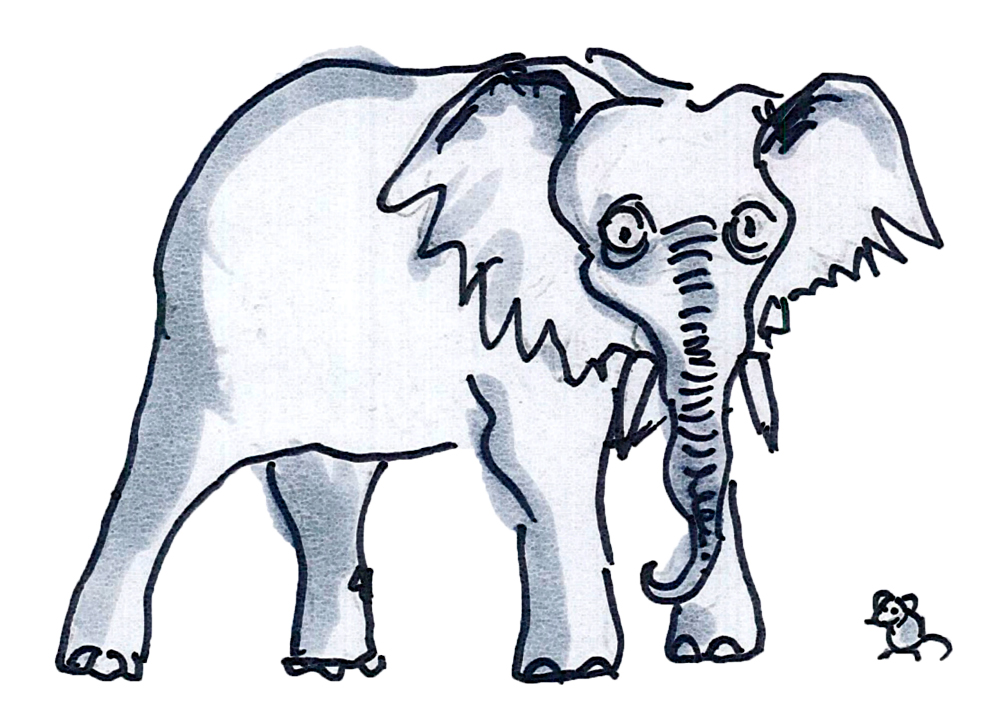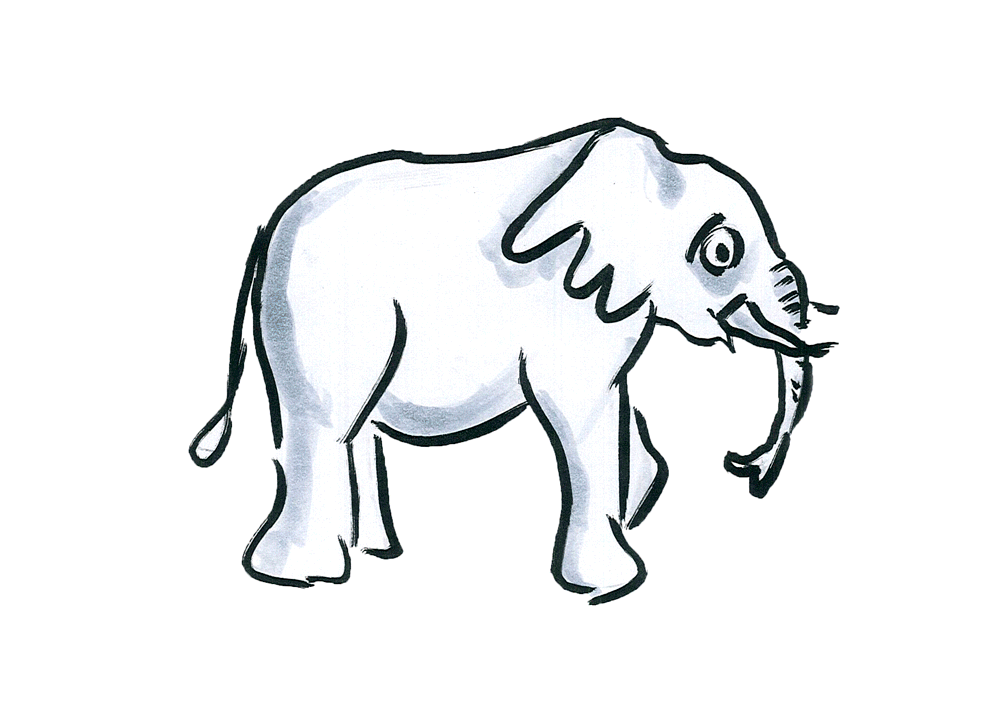Oh dear. There’s something not quite right with this animal.
It’s obviously cold, and yet this teeny little fur ball is dashing frantically across the ice, probing, sniffing, darting, never pausing, never resting, it just barrels on, ferociously hunting, hunting, hunting. That’s what shrews do. This one’s a short-tailed shrew. Shrews are very odd animals. They don’t slow down. They barely sleep. Like tightly wound springs, they unleash crazy amounts of energy, and then, out of some deep need, or some deep necessity, they release more. They can weigh less than a penny, and yet they must eat all the time, move all the time, hunt all the time. No other mammal behaves this way. Just consider…
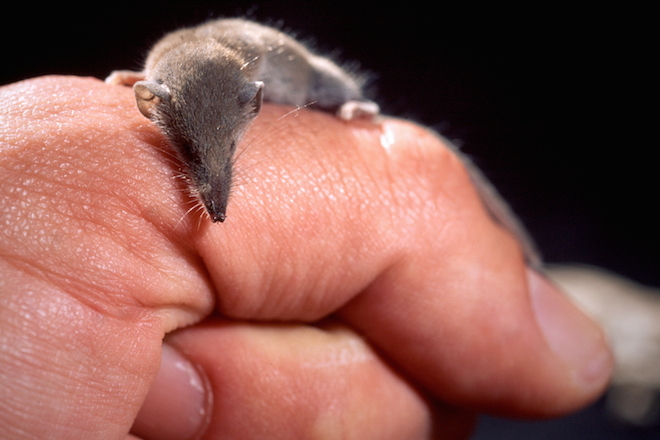
This little guy is the lightest mammal known to science. It’s also a shrew, a species found in the Mediterranean and in parts of Asia, called an “Etruscan” shrew, that, like our video-shrew, is constantly moving — on average, 13 times every second. Think about doing anything (even blinking) 13 times in a second. That’s beyond frantic.
To keep up its pace, its heart beats faster than a hummingbird’s (going as high as a record-breaking 1500 beats per minute). And so, shrews must burn a lot of fuel. Which means they have to constantly gulp air and gobble food. Every gram of this shrew’s body uses 67 times more oxygen than we humans do, and it eats nearly twice its body weight every day — just to stay alive. Twice its body weight!
If this shrew goes without food for just four or five hours, it’ll starve.
So by necessity the shrew spends its life furiously focused on hunting, snatching, biting. If you go to YouTube and type in “Shrew vs”, you’ll see them battling a crazy array of scary animals (scorpions! snakes!) And while we aren’t necessarily recommending a YouTube shrew-fighting binge, let’s just say that we wouldn’t bet against the shrew.
Something’s Not Right Here…
Now — there’s something uneasy-making about these shrews (other than the alarming ease with which they can take down a garter snake). They’re such an extreme life form.
Just to give you a sense of how crazy their appetites can be (and it’s not just shrews we’re talking about, it’s a bunch of teeny mammals), let’s do a quick exercise. Just below you will find two mammals, one big, one little. The top one is a vole (a small furry rodent about as big as a mouse), the bottom one an African elephant, the largest land animal in the world. Both voles and elephants love to eat grass. So in front of each, we’ve place a freshly cut pile of lunch.
Your job? You are a portion-adjuster. You decide the amount of grass each animal needs to eat every day. Just follow your intuition and move the toggle switch to the right sized meal. Go ahead, give it a go.
Not what you’d figured, right? We both thought the vole would need less — being so little. But no, the vole eats about 80 percent of its weight in food every day. The elephant, just 5 percent of its weight. Which means, relative to size, the vole has a much bigger appetite than the elephant. Every ounce of a vole needs 16 times as much food as an ounce of an elephant.
Why? Something odd is going on here. What if… (and we’re just wondering at this point..) what if big animals and little animals are built differently? Literally. From the bottom up.
The Big Idea
If you hold a tiny creature like a mouse in your hand (don’t try this with a shrew, because it’ll bite your finger), you can almost feel it whirring, brimming with energy. Clearly, lots of little animals (mice, chipmunks, squirrels) behave like this. On the other hand, the biggest mammals — elephants, whales, rhinos — seem to live at a quieter, slower pace. So there’s an obvious surface difference between big and little animals, but how deep does that difference go?
Well, looking at an elephant and a vole, they don’t seem that different.
Both are mammals. Both are made of cells. Both live on land, eat, poop, breathe oxygen, and move about. In a gross sort of way, you might think that elephants are just really, really, really giant voles, differently shaped of course, and with bigger bones to support their massive weight, but operating on similar principles nonetheless.
But the “Lunch Puzzle” gives us pause. If a chunk of an elephant can survive on a sixteenth as much food as the same-sized chunk of a vole, something’s got to be different on the inside — deep down. But what?
Big versus Little – Profoundly Different?
Well, here’s another clue. Take a look at the graph below.
It’s a collection of dots. In this case, each dot is a different animal. Going from left to right, it starts with the littlest animals (see our Etruscan shrew? It’s the very first dot at the extreme left because, as we know, it weighs less than a penny), and moving to the right you’ll see a mouse, a squirrel, a rabbit, a fox, a lion, a tiger, and so on. Way, way on the right is our pal the elephant.
This graph is measuring appetite. Not for grass. But for oxygen. The graph is asking, which animals are running so furiously they consume the most oxygen per body weight? That is, if you took a small chunk of shrew, fox, lion and elephant, each chunk the same weight, which chunk (which animal) is consuming the most oxygen?
Check it out! It’s just like our “Lunch Puzzle”. The pattern is the same. The littlest animal (the shrew) gobbles oxygen at a high, high rate (that’s why it’s high on the chart), just like the little vole gobbled grass. But as we move on to the bigger animals, their proportional need for oxygen goes down. You can see the dots dropping lower and lower as you move to the larger animals on the right.
Just as every ounce of a vole needs 16 times as much food as an ounce of an elephant, a similar pattern holds true for the air they breathe. When compared ounce for ounce, a vole gulps down about 11 times more oxygen than the elephant.
And so, an elephant isn’t at all like a giant vole. Per ounce of body weight, a bigger creature has a lower metabolism — its gulps less air, burns less fuel, and releases less heat — than a small creature.
And it must be this way. To see why, we’re going to do a little ‘thought experiment’. This isn’t a real experiment, and in this particular case not a particularly nice one either, involving as it does, a self-combusting elephant.

Note to Elephant: Remember, you are an imaginary elephant. Being a fantasy, it is not possible, we feel, for you to experience any actual harm. In fact, we wish to remind everybody that no actual elephant would EVER be harmed here at “Noticing.” We love elephants. But, moving on…
The Mystery of the Exploding Elephant
So, we’re going to take our big mammal and place it next to a teeny mammal, in this case, a mouse. As you can see, our elephant is MUCH bigger than the mouse.
How much bigger? Well, the mouse weighs just under an ounce (about 20 grams); the elephant 11,000 pounds (5,000 kilograms). In other words, that elephant weighs 250,000 times more than the mouse does.
OK, so that’s pretty big.
But there’s a problem here. If you go back to our last post, we saw that as a creature grows in size, its insides grow faster than its outsides (i.e. its volume grows faster than its surface area). If a little mouse were to grow 250,000 times bigger to become an elephant, once it gets elephant-sized, it has trillions and trillions of nice, warm cells bunched together in its torso, its legs, so it’s pretty hot in there. And, because it’s grown bigger, it also has more surface area — more skin — to let the heat out.
So it’s got a big problem. While the elephant has trillions more hot cells on its inside, it hasn’t got nearly enough surface area to let that heat out. It’s got 250,000 times more volume than the mouse, but only a piddling 5,000 times more surface area (more skin) on its outside, which leaves a crazy amount of heat – trapped, locked in – with no place to go.
If an elephant burned fuel at the same rate as a mouse or a shrew, its insides should get so impossibly hot, that at some point, it should just…..
…explode!
But elephants never do that.
And our elephant friend, puzzled by its continuing existence, says, “Isn’t that what my huge ears are for? To vent my extra heat?”
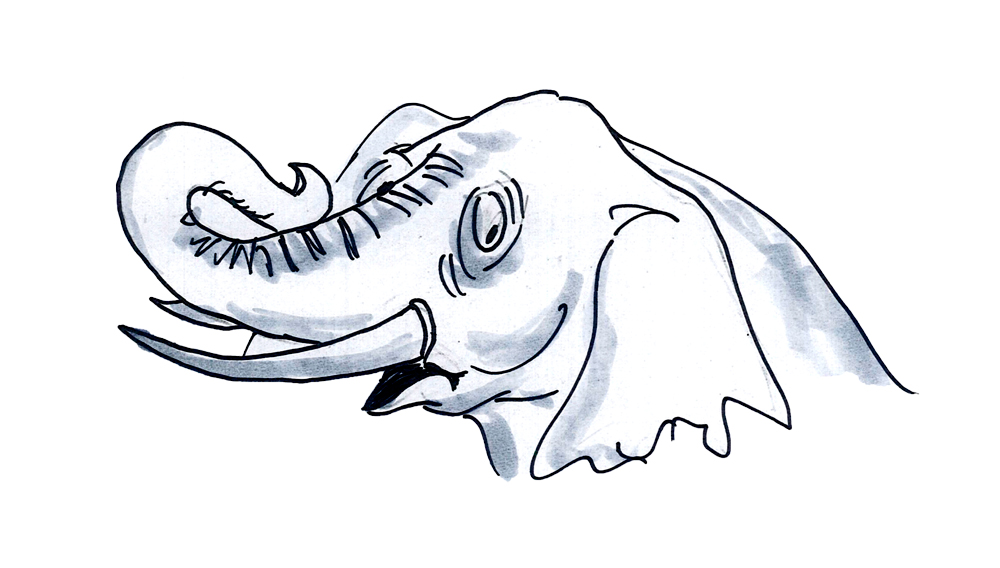
Indeed, elephants use their large, thin ears to dissipate heat, in much the same way that a car’s radiator does — a large surface area is great at radiating heat. But unlike a car radiator, elephant’s ears don’t have nearly enough surface to get rid of the amount of heat we’re talking about here.
In fact, if an elephant somehow had enough skin to release all of this the extra heat that we’re imagining, it would end up with great crinkly folds of skin, like a giant dimpled golf ball, or, says Princeton Professor John Bonner, like “a monstrous walnut”.
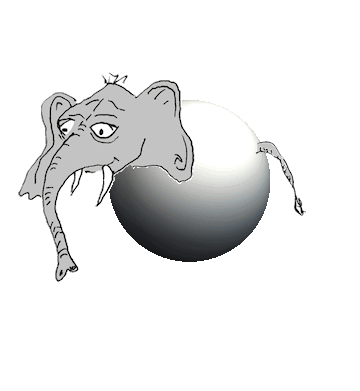
So how come real elephants don’t go up in flames?
We already know the answer — elephants don’t burn fuel at the same rate as mice do. That’s why they have such small appetites for their size.
Looking Deep Down
If you burrow down — all the way down — to a typical cell in an elephant, and then compare it to a typical cell in a mouse — amazingly, the two cells behave differently.
Elephant cells aren’t lazy. They’re always working, but compared to mouse cells, elephant cells typically do their job a little more slowly, burn less fuel to get the job done and, being more efficient, they run cooler.*
So that’s why elephants don’t spontaneously combust (and neither do we, much to Calvin’s relief.) An elephant is built from cooler stuff than a mouse. Even though an elephant has many, many more little heaters packed inside its body, each heater runs at a much lower setting. Says John Bonner,
A larger animal could not even exist unless its cells had a reduced rate of metabolism. It would either starve or burst into flames, or both.
Shrews, we now know, are at the other extreme. A shrew is built from hungrier, warmer stuff. Shrew cells are like Mexican jumping beans in a cocktail shaker.
Without its internal heaters turned up to-the-max, a shrew would leak out all of its heat and freeze. And this explains its furious appetite. Shrews are so insatiably hungry because, well, their cells are. If a shrew can’t find food, then, says John Bonner, it’ll suffer “irreversible internal damage after a few hours”. It’ll starve.
Small is Different
And so, all the way down to the level of the cell, the metabolic rate of each creature — how much oxygen it gulps, energy it burns, heat it releases — is carefully tuned through evolution to meet the challenges of its size. Big creatures aren’t giant versions of little ones, instead they’re built from cooler and calmer parts. Their internal fires must burn at a lower rate.
As far as we know, this wide-ranging rule holds true for most animals on the planet, not just mammals, but also birds, fish, crustaceans, snails, amphibians, reptiles, insects, and more. Thanks to this rule, our mammalian ancestors could grow from the twitchy, frenetic, shrew-like creatures that burrowed beneath the world of the dinosaurs into the lumbering giants that roam our world today.
And thank goodness for this scaling difference. Think what would happen if the bigger animals on earth had the temperament, the appetite, the needs of a ferociously hungry shrew? That would be so horrible, so inconceivably terrifying that it would be — of course! a Hollywood movie!
Made in 1959, “Killer Shrews” is the story of handsome boat captain Lorne Sherman (James Best) who lands his supply ship on an isolated island inhabited by a geneticist and his beautiful daughter Ann (Ingrid Goude). Ann’s dad has created a new breed of “blood curdling, horrifyingly poisonous” giant shrews, who must eat “three times their own weight in food” every day or starve. And then, all of a sudden, a hurricane cuts them off from civilization, just as the hungry shrews discover the warm taste of human flesh…
Uh-oh. The script doesn’t go there explicitly, but we know what poor Ann and Lorne are thinking as the shrews chew their way through the adobe walls of the lab, sniffing human food: “It’s dangerous to tinker with the gently scaling gifts of cellular biology,” or as Lorne prefers to put it, SHOOT! NOW!
Footnotes
- We’re indebted to John Bonner‘s lovely book Why Size Matters: From Bacteria to Blue Whales, for teaching us, among other things, that ‘why don’t elephants spontaneously combust?’ is actually an interesting question. His book is a fascinating tour of the science of size, and even includes some alarming facts that you probably don’t want to know.
- And a tip of the hat to David Haskell, whose wonderful book, The Forest Unseen, got us thinking about the restless life of a shrew. Every page of this book is an utter delight.
- You can watch The Killer Shrew online, if you’re so inclined. It’s also been colorized, and even been mocked on Mystery Science Theater 3000.
- The data in the metabolism graph is from White & Seymour (2003), with a few additions, for elephants: Langman et al (1995), humans: Henry (2005), and voles: Kurta & Ferkin (1991).
- *While it’s true on average the cells of larger animals have a lower metabolic rate than smaller ones, a few particular types of cells don’t fit this rule, and you can read about those here (or here, if you really want to get into it).

